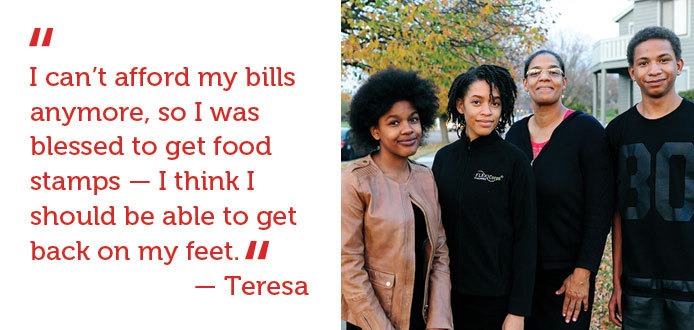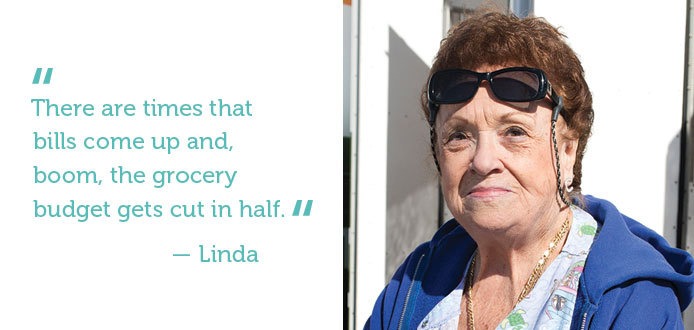Tough Choices for Food-Insecure Marylanders

Many of the more than 682,000 food-insecure individuals in Maryland face tough choices every day. Choices like buying groceries or paying bills, getting food or medicine, or even having to forgo some meals to ensure their children have enough to eat. Here you’ll meet six Marylanders who have had to face their own tough choices and hear why the food assistance network means so much to them.
When you donate to the Maryland Food Bank, you give us the ability to acquire and distribute enough food to provide millions of meals annually to some of the most vulnerable people in our state — children, seniors, and hard-working families.
What you may not know is that without your support, hundreds of thousands of hungry Marylanders would be faced with unimaginable choices between food, medicine, utilities, or rent.
When struggling to make ends meet is the norm, and every single dollar matters, deciding how to make the best use of funds can be a significant challenge.
The Economics of Touch Choices
While Maryland is one of the wealthiest states in the country, it is also one of the most expensive to live in. In recent years, wage growth in Maryland has been slower than most other states, but basic costs are rising faster.
Compared to their national averages, utility bills in Maryland are 22 percent higher and prescription drugs are more expensive. And just last year, the cost of one meal rose from $2.94 to $3.03 — a rate of increase nearly double the national average.
When a family of four needs $61,224 a year to survive but the majority of jobs in our state pay less than $42,000 annually*, the difficulty of making ends meet is crystal clear.

Touch Choices: Food or Medical Care?
A Feeding America study uncovered some sobering data on the monthly challenges that food-insecure individuals nationwide often confront.
Teresa, who was forced to leave her full-time job to help care for her child after she suffered a debilitating stroke, is typical of the 81% of respondents who reported having to choose between food and medical care.
“My daughter had a stroke, something you never imagine would happen to your child,” she said. “The insurance will cover a lot but there are other things, like her orthopedic socks that I have to pay out of my pocket and they’re expensive.
Like it’s $10 for one pair of socks and she’s gonna need those for not only school but outside of school, so you can’t just get one pair.”
And then there’s Cathy, a 60-year-old woman who suffers from a medical condition that can be eased by a healthy diet. “I have diverticulitis, and my doctor said that to prevent it from flaring up, I need to eat more fresh fruits and vegetables to get higher fiber. But that is so expensive,” she explained. “That’s why I am blessed that one time a month, I can come here and get fresh veggies,” she said.
Sixty-eight-year-old Janet, meanwhile, is much like the 30% of study subjects who have diabetes. She lives with a disease that requires both food and medication. “I am diabetic, and on 10 pills and three injections every day — even with the insurance, there’s like a $10 payment for each, and those add up,” she said.
“When I get these gifts of good foods, things like chicken and cabbage, I know I’m eating better. Without it, I’d probably start going to the dollar store again and getting the cheap stuff. I’m so thankful I don’t have to.”
Janet recalls one bad experience she had in trying to make the food she did have last longer. “I remember this one time when I stretched out a pot of spaghetti for too long. I guess it went bad because I got sick.

Touch Choices: Buy Food or Pay My Bills?
But balancing the cost of food with that of healthcare is just one of the many difficult choices food-insecure Marylanders are forced to make on a regular basis. Randy, a 43-year-old former full-time worker, suddenly found himself facing what 78% of study participants admitted to — having to choose between meals and utility bills.
“When I drove a truck full time, I wasn’t rich, but I didn’t really think about bills or food too much,” he said. “When that went away, it hit me really hard, and all I thought about was bills.”
“It was like a game,” Randy recalls. “‘how many days can I let the electric bill slide before they really turn it off?’ Who wants to live like that?”
Much like Randy, 59-year-old Linda struggles with paying for both utility bills and food.
“My phone has been shut off sometimes, which is important to have to call the doctor if I need to, but that’s not like the gas bill. I’ve had to call them and ask for extra time to pay,
she said.”
“But then I get staples from the food bank, which means I can afford my bills and sometimes even meat or chicken when I go to the store,” she added.
Touch Choices: Groceries or Security?
As a result of the food assistance she receives, Jennifer, a medical technician, has found not only relief from her worry over expenses, but an added sense of security.
“I live in the city, and someone broke into my apartment two years ago, so I had to put in an alarm system, she said. When I get this food, the money I save can go to the alarm system, which gives me security and comfort. I’m a single mom, and feeling safe in my own home means so much.”
While it is obviously at the forefront of what we do, your support allows us to do much more than provide food to those in need — it offers people like Teresa, Cathy, Janet, Randy, Linda, Jennifer, and other Marylanders an improved quality of life.
Over the past four decades, your support has allowed us to be flexible enough to develop, assess, and adapt a number of successful initiatives that target hungry individuals and families across all demographics and all parts of the state.
Programs such as Pantry on the Go, Farm to Food Bank, School Pantries, My Groceries to Go! (no longer available), and others may not completely eradicate the tough choices hungry Marylanders face, but we know they are helping to lessen the impact.
You Can Help Reduce Tough Choices For Your Hungry Neighbors
Your support for the Maryland Food Bank positively impacts the lives of hungry Marylanders statewide. From virtual food drives and online fundraisers to monthly gifts, workplace giving, and opportunities to volunteer, there are a variety of ways you can make a difference.
On behalf of the Maryland Food Bank, our network partners, and the hundreds of thousands of food-insecure Marylanders we serve — THANK YOU!
*United Way’s ALICE Report
Get updates on our progress in the fight against hunger
Want to see how your involvement directly impacts the well-being of your neighbors in need? Get the latest news sent to your inbox.







